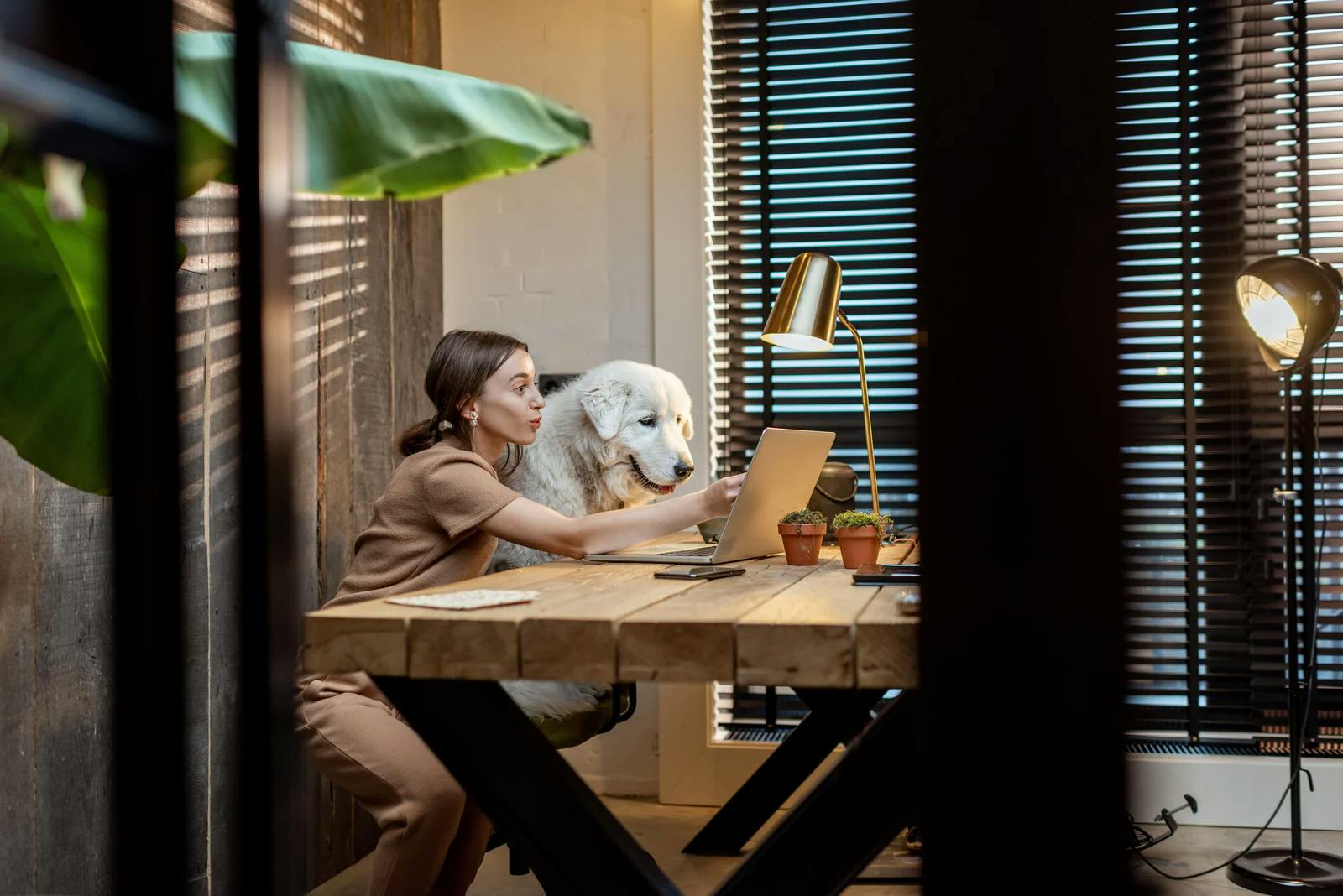Active location:
Select your country:

A pawfect wooffice - how to make your doggo the best colleague at work
Many studies have shown the benefits of letting the four-legged family member accompany you to work, and the trend of dog-friendly workplaces, lunch places and hotel rooms is only growing. But what impact does the dog actually have on how we work? How can we adapt the office so that it becomes really dog-friendly? And how do you make sure your dog can't wait for it to be Monday again?
Five benefits of dogs at work
Bringing your dog to work has many benefits - not only for the doggo, who gets to hang out with his pet parents all day, but also for you, your colleagues and even for the productivity in the workplace. Studies and surveys (which you can bring and show to your boss!) have shown that:
Having the dog in the workplace reduces stress.
Dog-friendly workplaces find it easier to find staff, have employees who are happier, stay longer, have less absence and are more committed to their work.
Dogs provide healthier routines in the workplace - they remind you that it's time to take a break, move around and play!
Dogs lead to better communication and atmosphere in the workplace - dog-friendly workplaces report that they have more positive relationships, both between colleagues and between colleagues and the boss!
Dogs increase productivity - well, even that's proven!
After seeing this list, maybe there is no reason left not to include the doggy? Well, of course we also need to take into account those colleagues who have allergies or fear of dogs. In this workplace, the problem was solved by having special dog zones in the office, where the employees with doggies could sit.
How should the office be designed for the four-legged?
To have a really welcoming environment where both two- and four-legged people enjoy being, it can be good to think about certain things. It is important that all dog owners take responsibility for their four-legged friends and that the office continues to work well for those who are not as dog-crazy as you. Here are some things to keep in mind:
Common rules for all dogs - agree on where the dogs can be and what they can do. Can the dogs be on furniture or not? Can food be brought to work? How do you handle the situation if a dog barks a lot or disturbs the other dogs?
Have lint rolls close at hand - bringing a couple of extra lint rolls to colleagues who sit near you and your dog can be a nice etiquette. There will be hairs all over the place sooner or later, no matter how much or how little the dog sheds.
Register attendance - the dog too! It is always good to know who is in the office, but it is especially important if an emergency should arise. If there are some dogs that do not like each other, it is also good to know which dog is at work which day.
Keep order in the dog's office corner - a cozy sleeping place where the dog can feel safe, and a place for a water bowl where it is OK to spill, is good to have. Remember to place the dog's things so that it does not pose a tripping risk to others.
Have a dog-free zone - where it is quiet. No matter how much you like dogs, it can be good to have a department or a room in the workplace that is always dog-free, if someone needs to leave for an important meeting without distractions and risk of barking in the background.
What is important to your dog in order for him or her to thrive at work?
Now - to the important thing, you doggo! As important as it is that your colleagues enjoy your dog, it is just as important that the dog enjoys his work so that he longs to go there every day. Here are some tips for the office to become the new favorite place!
Have a safe place - of course many of your colleagues also love dogs, but some dogs can be overstimulated by new people who want to greet, talk and play all day. Have a quiet resting place for your dog, for example under or next to your desk, where the dog knows it will not be disturbed. Make sure that two-legged or four-legged colleagues never disturb it when it is in its resting place, but let the dog come out and socialize when he or she feels like it!
Give your dog breakfast at work - dogs are rewarded with treats, and get positive associations where they get food. If your workplace allows it, give your dog his breakfast at work, but of course make sure it is in a place where it is calm and no competition from other dogs.
Get a clever toy the dog likes - for dogs that easily get bored during a long working day, it is good to have something challenging it can kill some time with. It can be both a chew toy or something you can hide the dog's food in which it has to work with for a while. Otherwise, your dog might invent its own tasks, such as examining if your colleague might have forgotten some old biscuit packaging in his drawers.
Let your dog hang out with its office mates - for lunch walks and breaks, it is a good idea for the dog to also socialize with his four-legged colleagues (if he wants to), but this can be done in a neutral place that the dog does not consider his. Always make sure that the dog is not surprised while resting in his bed, even if it is only for play! It then becomes clearer for the dog when it is okay to fool around, and when to lie down and relax - clear routines for when it is work and when it is play makes it easier for both the dog and the person working.
Have a friend - for dogs that are very attached to their own pet parents, it can be good to have a colleague that the dog can get used to a little extra, so that it does not become a problem if you ever need to leave for a quick errand and can not take the dog with you. Let the colleague give the dog food or treats, or sit and work near you so that the dog gets used to him/her and they become friends.
Create a positive feeling - If your dog has difficulties with new environments, let him visit the office for a short time in the beginning, and create positive associations with treats and praise. If there are a lot of dogs in the workplace and your dog has difficulty with new acquaintances, take it easy and let him or her get to know one dog colleague at a time, so as not to create too much stress. Remember that your dog should always be able to go to his resting place if he needs to.
So, now we know exactly what is needed for both the boss, colleagues and the dogs to love going to work and many wonderful lunch walks to look forward to!
Stay pawsome from staffy Alva and the other four-legged friends at the petgood office (who are not biased at all or have had anything to do with this post ...)







